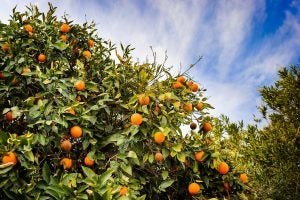Rivalry drives us — that instinctive need to root for the hero, while heaping merciless shade at the villain.
We join these “affinity camps” to get our competitive fix. Us vs. them. The New York Yankees vs. the Boston Red Sox, Marvel vs. DC, Apple vs. Microsoft. My team, comic brand, or ecosystem is superior to yours, because XYZ.
How do we choose these undying loyalties? It could be social or geographic. And these allegiances are absolute; definitely no room for waffling or backing out. It’s like mob initiation — this is for life.
And one other thing, absolutely no bandwagon joining — except, it seems, in agriculture.
Witness organics. Despite little evidence of its supposed merits, devotees will steadfastly defend their “team.” It’s widely touted in marketing materials to be safer, healthier, and more wholesome than that horrid “chemical-obsessed ag”!
In the purity sweepstakes, default assumptions make the brand. Why? Ask the fans. You’re nearly guaranteed to get the same answer: pesticide free (false), but if they’re used, they’re infinitely safer. They just have to be, because they’re naturally derived (usually, but not always).
Here’s where the bandwagon takes insidious root. Organics gets dressed up in this pleasing aesthetic, but it’s an otherwise shallow factual façade.
When the National Organic Standards were first released, the U.S. Department of Agriculture decided to farm out (bad pun) organic aspirants to the Organic Materials Review Institute (OMRI). OMRI then evaluates, approves/denies, and adds to the “master list” of green lit substances.
However, the overall evaluation is based on a very pliable set of standards. Any OMRI approved materials must be 1) naturally derived, or 2) if synthetic, demonstrated to not adversely impact the environment or human health. Already, one can see multiple logical short circuits with this approach. Natural is given an automatic health halo. Synthetic is automatically deemed suspect and worthy of additional scrutiny.

Copper sulfate is the poster child of organic contradictions. It has a nasty tendency to build up in the soil after repeated applications, never breaks down, and gets quite toxic.
Is it natural? Adherents claim the Romans used it in their heyday. True, but it isn’t extracted from a plant or otherwise mined from the earth — it’s produced industrially. And it’s widely documented to have adverse environmental impacts. It also has a very high use rate per acre, meaning more active ingredient being introduced into the environment, when compared with synthetic alternatives that work better, have shorter residence time, and lower use rates.
Why does it get a pass? It seems to be about the only thing that works in orchards for (organic) disease management. The organic camp claims that they’re clamping down by requiring a use justification — when all other avenues have been exhausted. Does a philosophy of convenience trump “the science”?
Additionally, one has to appreciate the irony of Botox (a neurotoxin made by the bacterium Clostridium botulinum). Granted, it isn’t a pesticide, but it is natural — and the undisputed toxicity tsar. Nothing on Earth, natural or synthetic, comes remotely close to its potency. A speck smaller than a grain of sand can kill a fully grown adult, but it’s quite useful to treat wrinkles or migraines when diluted. The old dose-makes-the-poison mantra — another factoid lost on the organic contingent — and another glaring inconsistency revealed.
Then there’s the Bt paradox. Bt stands for Bacillus thuringiensis, a common soil bacterium. It was found to produce a “natural” toxin that manages a number of pest groups. All we have to do is mass rear spores of the bacterium (which produce a pesticidal warhead of sorts), formulate as a sprayable pesticide, and voila, reliable pest control!

Its hallmarks are a lack of collateral damage against beneficials, and a non-existent ecofootprint. As a result, it’s been a mainstay in agriculture for over 90 years. It predates organics by decades!
Yet if we engineer plants to make this exact same material in-house (one with a 90-year track record of safety) it’s suddenly substantia non grata (like persona non grata — except a substance in this case) in organic circles — because it’s a GMO and “unnatural.” I can’t imagine how mass rearing and commercializing a bacterium is natural — but I digress.
Then there’s the real doozy — materials with the exact same active ingredient (the ai, or workhorse of the formulation actually doing the pesticidal job) that have both organic and conventional labels.
How can this be? Apparently the main ingredient might pass OMRI muster, but the inerts (other additives) in the formula may not. So, in a brilliant marketing twist, two subtly different products are unveiled — with different trade names.
A perfect example is the active ingredient Spinosad. Another bacterial pesticide, it has a conventional formulation called SpinTor, and an organic equivalent, Entrust.
Unfortunately, it seems such “trust” might be misplaced. A study out of Australia found that low, chronic doses of Entrust can have negative impacts on beneficials.
Though I have doubts about the real-world relevance of the study, this isn’t to singularly sound the alarm about Entrust, its main ingredient Spinosad, or even pesticides in general — just to highlight the importance of a through and impartial scientific evaluation across the board.
Indeed, the paper takes great pains to emphasize that the organic label doesn’t (and shouldn’t) imply safety. Every material should be judged on its own merits, not exempted by some unfounded devotion.
The lengths some will go to defend or misrepresent organic pesticides often descends into parody. Beware bandwagonism when choosing your “team.” A pesticide is a pesticide, nature doesn’t discriminate, nor do pests — nor should we. The intent is the same — manage the pest, and do it safely. Where older “legacy” chemistries exist, they should be phased out in favor of up and comers with more favorable attributes.
Pesticide choice shouldn’t be about rivalry and allegiance. It’s about what works and what doesn’t. It’s advisable to hold a mock draft and build your own fantasy team of free agents, those best aligned with your values. Let’s dispense with the organic/conventional pesticide rivalry and acknowledge that they’re an essential tool, whatever the system.
Tim Durham’s family operates Deer Run Farm — a truck (vegetable) farm on Long Island, New York. As an agvocate, he counters heated rhetoric with sensible facts. Tim has a degree in plant medicine and is an Associate Professor at Ferrum College in Virginia.



